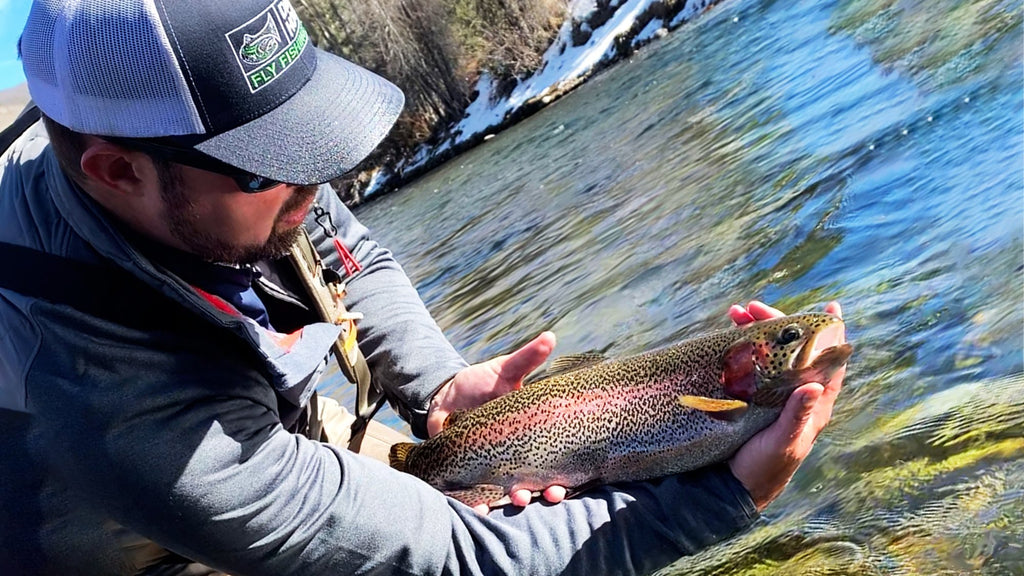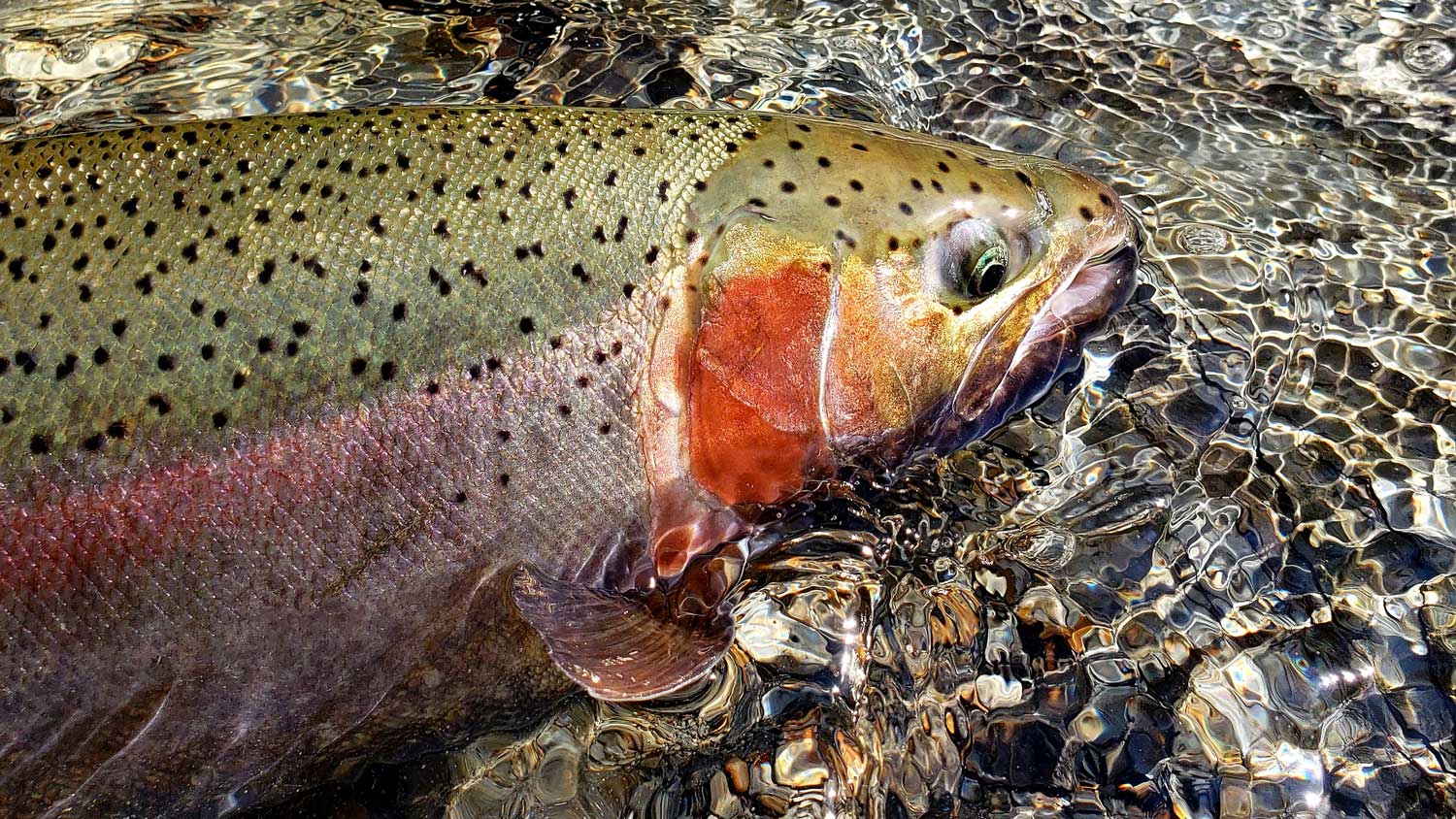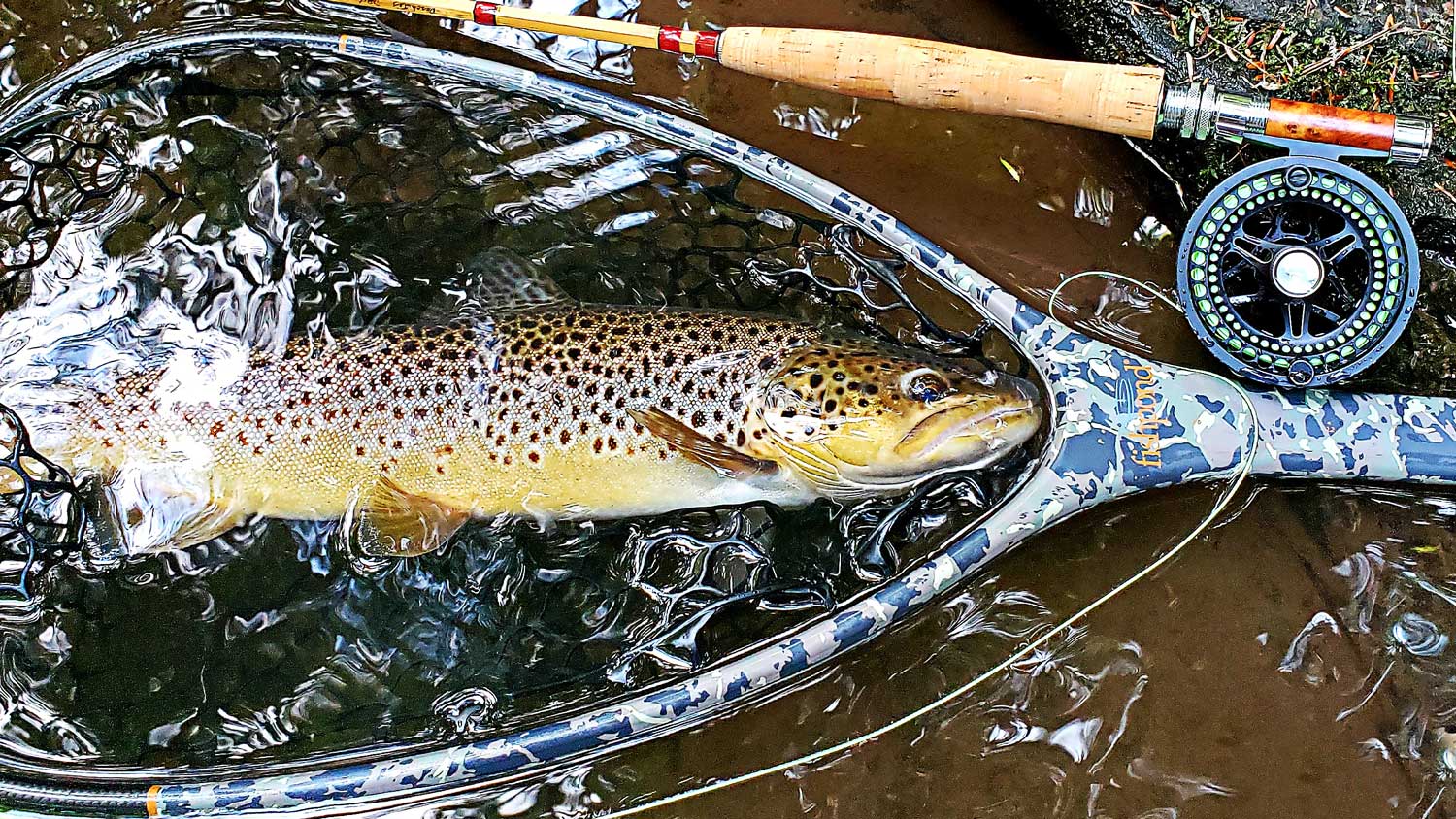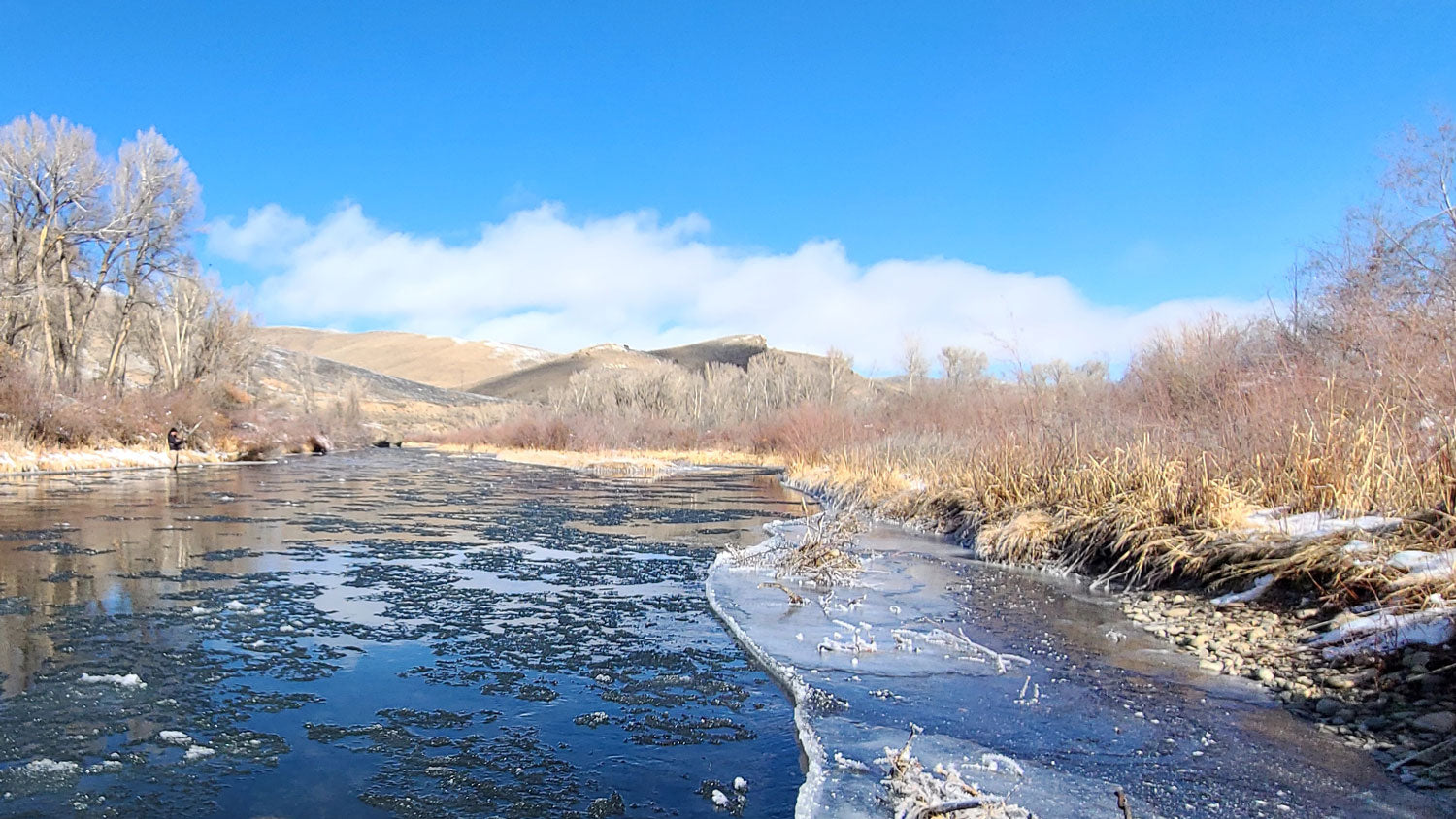Sight fishing is a visual method for catching trout, and it's great fun. As the name suggests, sight fishing involves spotting fish in the water first and then trying to get them hooked on your fly. Although it can be difficult, sighting the fish before you cast does give you a bit of an edge.
You can watch the trout and get a sense of what they are feeding on and what fly may be best. It can also give you an opportunity to find the best place for where you should cast. Judging the depth, in particular, is essential when selecting your fly. Sight fishing allows you to make adjustments to your strategy while you are fishing too. For example, if the trout are feeding on emergers but not breaking the surface you might want to start out with a dropper rig to entice them.
Fly fishing by sight is one of the most challenging yet rewarding ways to catch fish, but there is a steep learning curve. This how-to guide will tell you everything you need to know about sight fishing for trout.

Sight Fishing For Trout In Rivers
Finding the best fly fishing spots
The first step is to find some trout, so you need to understand their needs and where they are most likely to live. There are a few key things that all trout need, and knowing how to identify areas that meet these requirements allows you to pick the best spots.
Trout need highly oxygenated water, and they like a lot of cover. Areas with shelter from predators like otters and birds of prey, are likely to have a high concentration of trout. They are also relatively lazy feeders, and they don't like to move very fast. As a result, they want cover from heavy currents and plenty of food.
If you scout out some spots where all of these needs are met, there's a good chance that you'll find some trout there. However, there is something to be said for the unconventional spots that are not necessarily optimized for trout. These are less likely to be overfished, and there is less competition from other anglers.
Trout have a knack for survival, and even a small three-foot pool of water can hold a sizable trout. These smaller water bodies tend to be overlooked, but it's worth casting and seeing if anything bites.
Spotting a trout
Once you have identified a spot that you think is good, it's time to start looking for trout. Spotting a fish is a lot harder than people realize, and it takes some practice if you are new to sight fishing.
The best method is to stare at the water in one spot and wait until you see something in your peripheral vision. Usually, you will notice a trout when you see the flick of a tail or the white inside their mouth. When you spot a fish, keep your eye on it and watch it for a while.

It's important to watch the trout closely and monitor its behavior before you cast. If the trout are not feeding and is sitting motionless, it is unlikely to be interested in your fly. You will have the most success if you find fish that are actively feeding instead of resting.
Fly Fishing Techniques When Sight Fishing for Trout on Rivers
The best sight fishing techniques vary depending on whether you are fishing in a river or lake. These are some of the most common trout fly fishing techniques on waterways.
Dry Fly Fishing
Dry-fly fishing is one of the more popular techniques among anglers because you get a clear view of the fly, making it more exciting and easier. It involves using fly fishing flies that imitate small midges that float on the surface of the water.
Usually, it's best to cast upstream or upstream and across, letting the fly float back down towards you. It would be best to manage how your line and leader unfurl (turnover) so the fly is as attractive as possible to the trout.
In the winter months, trout tend to swim deeper, so dry-fly fishing is not always the most effective method.
Nymph Fly Fishing
Nymph flies are flies designed to sink faster and sit closer to the bottom of the water. In the winter, trout are less likely to come near the surface, so dry fly fishing is far less effective. A nymph fly imitates the small bugs and eggs that trout feed on. This method is a visual one, which relies on watching your indicator or fly line for slight movements when a fish bites.
Sight Fishing For Trout On Still Water
Finding the best fly fishing spots
The behavior of trout in still water and streams is very different. In streams, they are usually stationary, letting the current move past them and bringing food. In still water, on the other hand, they are continually moving around. They need to move to find food and to maintain a constant flow of oxygenated water over their gills.
This constant movement means that you need to work harder to find the perfect spot when sight fishing for trout in still water. Although they move around a lot, they tend to gravitate towards certain areas, depending on the availability of food and the temperature.

Most species of trout, including rainbow trout, prefer water temperatures between 55 and 60 degrees. Brown trout often seek out warmer temperatures, but you are unlikely to find trout in warm water lakes (70 degrees or higher). Even if you have the best flying fishing kits, you won't have any success unless you can pinpoint the lake's right area to cast in.
In shallow water lakes, the temperature tends to be pretty consistent, but in deep lakes and reservoirs, the temperature varies throughout the water column. The surface is generally much too warm for trout in deep water, so they are usually found deeper where it is cooler. This means that sight fishing techniques are less effective in deep water lakes.
In smaller lakes, the deepest sections are usually only a winter refuge for the trout, and they typically gather around the banks.
Spotting a trout when fly fishing on still water
On lakes, the shoreline is an excellent area for spotting trout. The sun shines right through to the bottom, keeping the water nice and warm. There is also an abundance of food on the shoreline because many insects like ants and beetles are blown into the water from surrounding vegetation.
Trout in still water also like to stick to specific, well-defined areas to consistently search for food. If there are any logs in the water, for example, you are likely to find some trout swimming around. Trout like to hide beneath the cover provided by these logs, so sight fishing may not be possible. It is worth checking to see if you can get a clear view or not.

They are also attracted to areas with low hanging trees for a number of reasons. Firstly, it provides some shade, which helps to manage the temperature in the water. Secondly, it provides some protection from airborne predators, so any areas near the shoreline with good tree coverage are likely to have some trout swimming around.
You can get quite a lot of glare from the lake, so it's a good idea to wear a cap and some sunglasses so you can get a clear look at the trout. Polarized glasses are perfect for reducing glare and giving you a clear line of sight.

Approach the water slowly, and you should hopefully see some trout swimming around in the water. In still water, they are less likely to have a clear direction, so make sure that you watch for a while to determine which direction they are moving in and whether they are feeding or resting.
How to cast when sight fishing for trout in still water
Your casting technique depends on where you are fishing for trout. If you can see a lot of activity around a log in the water, it’s best to use flies that sink into shallow water. Cast out close to the log and let it sit for a while. Hopefully, this will entice the trout, and they will come out from underneath the log to strike. You may need to experiment a bit to coax the trout from under their log, so make sure that you invest in the best fly fishing kits.
In areas underneath an overhanging tree, you need to keep your casts low, so you don't get caught in the branches. Let the fly rest on the surface of the water for a few seconds before using short, sharp movements. This mimics a small insect trying to move over the water.
Be gentle when casting because a splash from a fly hitting the water can alert cautious trout and scare them off.
Tips To Improve Your Sight Fishing
Now that you know the basics of how to spot trout in rivers or still water, how to pick the best flies for fly fishing in different areas, and how to adapt your casting technique to different scenarios, you’re ready to get started. But sight fishing is a big challenge, so here are some tips to help you improve your technique and catch more trout.

Take your time
This is good advice for trout fly fishing of any kind, but it's especially important when you are sight fishing. Trout are great survivalists, so they have excellent camouflage. When they find a good spot in a river, they sit there and let the current bring the food to them. Even when they do move, their movements are very fluid, and they blend into the water. So, they're very hard to spot, and it will take time. If you act too quickly and rush your cast, you can easily scare them off. Sometimes, the best thing to do is bide your time and wait for the perfect moment.
Look 'through' the water, not 'at' it
It's difficult to grasp this concept when you first start, but once you get the hang of it, you will find it a lot easier to spot trout when sight fishing. Instead of staring at a spot on the top of the water, look through it to the bottom of the water. The trout aren't sitting on the surface. They're sitting at different levels throughout, so looking through the water increases our chances of spotting them.
Take your chances
There is a fine line to walk when sight fishing because patience is critical, but you could miss your chance if you wait too long. If you see something that looks like a trout, assume that it is one and cast near it. Worst case scenario, it isn't a trout, and you haven't lost anything. But if you are too cautious, you could end up missing opportunities to catch fish. Remember, their camouflage is excellent, so if you see something that moves, take your chance.
Stay on the move
Again, patience is essential, but if you've been watching the same patch of water for an hour and you haven't seen anything, you need to move to a new position. Moving a short distance to the other side of the river or a new spot further downstream could make a big difference. Eventually, you will get a feel for where the trout like to gather, and as you fish the same spots more often, you will get better at finding fish.

Pay attention to the position of the sun
When you are moving around and looking for new spots to fish, pay attention to the sun's position. Glare is a big problem when sight fishing, and if the sun is bouncing off the water straight into your eyes, you're not going to spot anything. Wearing a good set of polarized sunglasses helps a lot, but you should also pick spots based on the sun's position.
Sight fishing is easiest when the sun is high and shining straight down on the river because you don't get any glare. But this is not always the best time to fishing as not only is it easy for you to see, its also easy for the trout to see as well.
It's important to think about your shadow, too, because if you're casting a huge shadow over the water, you'll scare all of the fish off in no time. Try to position yourself somewhere where you don't cast too much of a shadow, and there isn't too much glare.
Certain conditions are best for certain types of water too. For example, tight rivers and gorges with high walls are particularly good in overcast conditions. But in sunny conditions, the contrast between the shadows caused by the canyon and the bright sun can make it harder to spot trout in the water because your eyes don't adjust well.
Don't underestimate blind fishing
Sight fishing is all about spotting trout in the water, but you shouldn't underestimate the potential of blind fishing. If you find a promising spot, but you can't see any fish for a long time, you might be tempted to give up. But before you assume that you were wrong about the spot, you should try casting a few times anyway.
You'll often find that you did choose the right spot, but you didn't spot any fish. If you cast out, you might still get a bite. You never know unless you try, so it's always worth trying blind fishing from time to time before you move on.

Invest in good quality flies
Trout fly fishing requires a lot of trial and error, especially when sight fishing. Investing in a range of fly fishing flies gives you the flexibility to fish at different depths and try a range of strategies. When fishing in rivers around the banks, dry flies that sit on the water's surface are best, but in lakes where the fish are more likely to swim deeper, wet flies are best. Buying the best fly fishing kits allows you to be ready for various fishing spots and situations.
Sight fishing is such a rewarding way to fish for trout, but it can be challenging, especially for beginners. But if you follow this guide and experiment with different strategies, you can master the art of sight fishing for trout.

Matthew Bernhardt, a third-generation Coloradan, grew up at the forefront of the state’s fly-fishing revolution, enjoying time on the water, side by side with experienced guides and lifelong anglers.
By combining his passion for fly-fishing with input from other experienced fly-fishers and guides and his fine arts degree from Colorado State University, Matthew spent five years carefully developing the Drifthook Fly Fishing System, built to help every angler catch more trout.
When he’s not spending time with his wonderful family, you’ll find him out on the water catching MONSTER trout, and he anxiously looks forward to the day when his kids are old enough to join him there.






